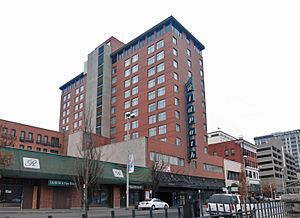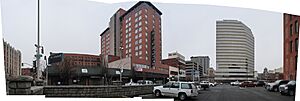Ridpath Hotel facts for kids
Quick facts for kids Ridpath Club Apartments (formerly the Ridpath Hotel) |
|
|---|---|

The Ridpath in 2012
|
|
| Former names | WestCoast Ridpath Cavanaugh's Ridpath Hotel |
| General information | |
| Status | completed (closed 2008 as a hotel, currently apartments) |
| Architectural style | Modernism |
| Address | 515 W Sprague Ave. Spokane, Washington |
| Coordinates | 47°39′25″N 117°25′12″W / 47.6569°N 117.42°W |
| Current tenants | 200+ |
| Completed | 1952 (Ridpath Tower) 1906 (Y Building) 1889 (Halliday Building) 1963 (Executive Court Building) |
| Landlord | naiblack |
| Height | 158.55 ft (48.33 m) |
| Technical details | |
| Structural system | Steel |
| Floor count | 13 |
| Design and construction | |
| Architect | Ned Hyman Abrams |
The Ridpath Hotel is a group of four buildings in Spokane, Washington. It includes the Ridpath Tower, the Halliday Building, the Y Building, and the Executive Court building. The Ridpath Tower is the main part of the hotel. It was designed by architect Ned Hyman Abrams.
The original Ridpath Hotel opened in 1900. It was a hotel for 108 years, making it Spokane's longest-running hotel. Sadly, the first building was destroyed by a fire in 1950. A new tower was built and opened in 1952. The hotel closed in 2008. After a big renovation, it reopened in 2018 as the Ridpath Club Apartments. It now offers "micro apartments," which are small, affordable homes.
Contents
History of the Ridpath Hotel
Colonel William Ridpath started the Ridpath Hotel in 1899. The first building opened its doors in 1900. This first hotel faced two fires. The first fire was in 1902, but the building was fixed. The second fire happened on February 28, 1950. It burned for 13 hours and damaged the building so badly it couldn't be saved. The fire caused about $1 million in damage.
After the fire, the old hotel was torn down. A new 12-story tower was built in its place. This new tower opened in 1952. The Ridpath Hotel was even used for filming the 1985 movie "Vision Quest."
Building the New Ridpath Tower
Just three months after the big fire in 1950, work began on the new Ridpath Tower. This new building was planned to be 12 stories tall. It would have 250 rooms and a strong steel frame. It was built on the same spot as the old hotel.
The new Ridpath Tower was very modern for its time. It had special features like a drive-in garage in the basement. All the rooms had outside views. The bathrooms were modern with tiled walls. It also had fast, self-leveling elevators. The building was also used for more than just a hotel. It had shops on the ground floor. The third floor was used for offices. Later, a glass-enclosed 13th floor was added. This floor had a club and a restaurant.
The new hotel cost over $3 million to build. It officially opened in April 1952 with a big celebration. Through the 1950s, 60s, and 70s, the Ridpath was Spokane's best hotel. It hosted many parties, art shows, and events. Famous guests like Elvis Presley and Michael Jackson reportedly stayed there.
Growing the Hotel Complex
During these busy decades, the Ridpath Hotel grew bigger. In 1961, the Spokane Hotel across the street was taken down. An addition to the Ridpath, now called the Executive Court Building, was finished in 1963. In 1971, the hotel owners bought the Halliday building next door. This building was built in 1889. They removed the top five floors of the Halliday building. The ground floor was updated and connected to the hotel. This created a modern space with air conditioning and heating. The Ridpath family owned the hotel until 1988, when they sold it to a new group of investors.
The Hotel's Decline
After the Ridpath family sold the hotel in 1988, it started to decline. The Ridpath family had always kept the hotel modern and updated. They added new features and expanded the building. But the new owners didn't invest in updates. The hotel needed new elevators and a fresh look inside.
Because the hotel wasn't updated, many of its features became old-fashioned. The hotel's rooms, once considered large and modern, were no longer as popular. The Ridpath started to be forgotten as newer hotels offered bigger rooms and more modern styles.
Changes in Ownership and Closure
After several years of decline, the hotel was sold again in 1998. Six years later, in 2004, the owners sold parts of the hotel. They needed money for other hotels they owned. This was the start of the Ridpath being owned by different people. Before this, one company owned the whole property.
The Executive Court building was sold to investors who wanted to turn it into apartments. The rest of the hotel was bought in 2006 by a hotel company from Las Vegas. But over the next two years, the hotel's condition got worse. Its business also declined. To try and raise money for improvements, the Las Vegas owners sold parts of the hotel to many different owners. This happened even though some investors wanted to buy the whole building.
The hotel suddenly closed in August 2008. Because many different owners now owned parts of the building, it became very complicated. There were problems with shared costs, maintenance, and safety rules. In 2011, the city of Spokane told the owners to clean up the property. Six months later, no one was allowed to stay in the building because it didn't have a working fire safety system.
Saving and Renewing the Ridpath
Spokane has a good history of saving old buildings and giving them new uses. Nearby, the Fox Theater, Davenport Hotel, and Steam Plant Square were all restored. These projects helped make downtown Spokane a lively area.
Even though it would cost money to tear down the Ridpath, city leaders believe it's important to save it. They think a restored Ridpath Hotel can help "stabilize downtown." They are working with developers to find a way to save and update the building. City leaders see the area around the Ridpath as a link between the busy downtown and the growing University District. They hope the renewed Ridpath will be a key part of this area.
Future Plans for the Ridpath
As of 2012, a group of developers had a plan to buy the entire Ridpath complex. They planned to spend $25 million to turn it into an "entertainment center." Some things would change, like the famous "R-I-D-P-A-T-H" letters on top of the hotel. But the goal was to make the building useful and exciting again. This would bring back the spirit of the original owners, who always updated the hotel.
The small hotel rooms, which were a problem before, would be fixed. Multiple rooms could be combined to create larger suites. Also, the old Halliday Building would be changed into a grand entrance for the hotel. Three more floors would be added to it. These new floors would have ballrooms, a nightclub, and a rooftop patio for events like weddings.
Images for kids


